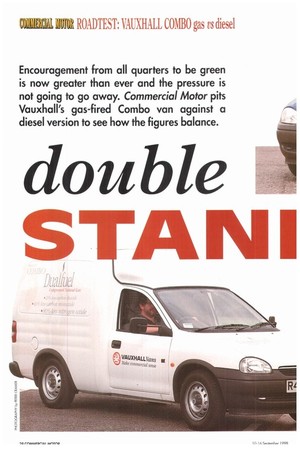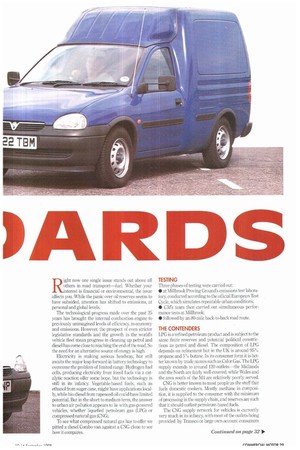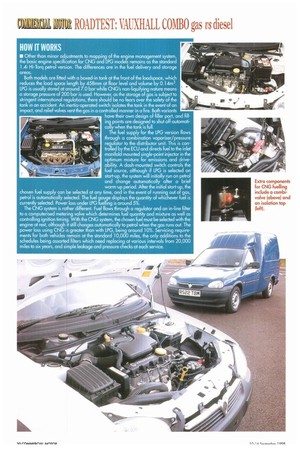ROADTEST: VAUXHALL COMBO gas vs diesel
Page 32

Page 33

Page 36

Page 34

Page 35

If you've noticed an error in this article please click here to report it so we can fix it.
Encouragement from all quarters to be green is now greater than ever and the pressure is not going to go away. Commercial Motor pits Vauxhall's gas-fired Combo van against a diesel version to see how the figures balance.
double S
Right now one single issue stands out above all others in road transport—fuel. Whether your 'Merest is financial or environmental, the issue affects you. While the panic over oil reserves seems to have subsided, attention has shifted to emissions, at personal and global levels.
The technological progress made over the past 25 years has brought the internal combustion engine to previously unimagined levels of efficiency, in economy and emissions. However, the prospect of even stricter legislative standards and the growth in the world's vehicle fleet mean progress in cleaning up petrol and diesel has come close to reaching the end of the road. So the need for an alternative source of energy is high.
Electricity is making serious headway, hut still awaits the major leap forward in battery technology to overcome the problem of limited range. Hydrogen fuel cells, producing electricity from fossil fuels via a catalytic reaction offer some hope, but the technology is still in its infancy. Vegetable-based fuels, such as ethanol from suger cane, might have applications locally, while bio-diesel from rapeseed oil could have limited potential. But in the short to medium term, the answer to urban air pollution appears to lie with gas-powered vehicles, whether liquefied petroleum gas (LPG) or compressed natural gas (CNG).
To see what compressed natural gas has to offer we pitted a diesel Combo van against a CNG clone to see how it compares. TESTING Three phases of testing were carried out: • at MilIbmik Proving Ground's emissions test laboratory, conducted according to the official European Test Cycle, which simulates repeatable urban conditions; • Cil/fs team then carried out simultaneous performance tests at Millbrook; • followed by an 80-mile back-to-back road route.
THE CONTENDERS LPG is a refined petroleum product and is subject to the same finite reserves and potential political constrictions as petrol and diesel. The composition of LPG depends on refinement hut in the UK is around 95% propane and 5% butane. In its consumer form it is better known by trade names such as Calor Gas. The LPG supply extends to around 120 outlets—the Midlands and the North are fairly well covered, while Wales and the area south of the M4 are relatively poorly served.
CNG is better known to most people as the stuff that fuels domestic cookers. Mostly methane in composition, it is supplied to the consumer with the minimum cif processing in the supply chain, and reserves are such that it should outlast petroleum-based fuels.
The CNG supply network for vehicles is currently very much in its infancy, with most of the outlets being provided by Transco or large own-account consumers such as bus garages. Fuelling limes at these high-pressure points are comparable to filling with conventional fuels. Fleet operators, however, have the option of connecting their own filling system to the domestic gas supply network, and British Gas offers an inexpensive refuelling device which could be used at the driver's home.
Most hauliers can't afford to be too charitable-any move towards greener transport has to be cost-effective.
• SUMMARY
The fundamental question to be resolved is whether you can obtain fuel easily, either at a nearby public fuelling point or within your own infrastructure.
If you have to drive 50 miles to fill up, it rather defeats the object. However, based on this admittedly limited experiment, the running costs (at current taxation levels) of CNG and diesel are equal or substantially lower than petrol. The extra capital cost of a CNG van over the diesel version if the Powershift grant is obtained is just £390.
The figures speak for themselves. If your operation is largely restricted to local deliveries and you are within range of a fuel supply point, there is no financial argument against going green.
Remember 11M Government's commitment to pricing conventional fuels ever higher-the sooner you can get on the alternative road, the more you will save.
C by Colin Barnett
VAUXHALL'S ALTERNATIVE POSITION
• Vauxhall has been a major pioneer of alternative fuel production vehicles. Dualfuel petrol/LPG versions of its Vectra and Omega saloon cars, as well as the CNG and LPG versions of the Combo high-cube van, are currently available, and the range will soon expand to include Vectra and Omega estates as well as the new Ash-a and Astravan. Vauxhall's current policy is to take completed vehicles from various European plants to its dedicated alternative fuel conversion centre near Luton. All the converted vehicles can be ordered and collected from any Vauxhall dealer and carry the regular warranty.
COSTINGS
Vehicle cost (ex-VAT) £10,495* £8,530 29,125 . e‘d 6.50kg 9.47 litres" 6.51 litres Fuel cost (pump price) £4.42 £6.21" £4.27 .it/ 10Likm, 38.2(7.4)" 38.2(7,4)" 55.6 (5.1)
pence/mile(km) 5.4 (3.3) 7.8(4.8)" 5.5 (3.4)
*Up to £980 may be reclaimed-see Powershift box.
"Figures calculated on basis of relative energy content of CNG and petrol.
COMPARITIVE EMISSIONS ON URBAN CYCLE (Om) Total hydrocarbons 0.12 0.07 0.07 Carbo onoxide 0 27 0.43 0.37
Carbon dioxide 144.8 181.5 156.7
Nitrous oxides 0.04 0.18 0.49
Sulphur dioxide (max) 0.0013 0.05 0.05
PM10 particulates 0.002 0.003 0,04
Fuel consumption 6.3 7,7 5.86 (litre/100km, for CNG kg/100km)
PRODUCTIVITY
GVW (kg) 1,620 1,620 1,670 Front axle (kg) 740 740 790 Rear axle (kg) 970 970 970 Kerbwt with driver (kg) 1,213 1,098 1,152 Net payload Ikg) 407 523 518 I.-cy ,me 2.72m:1 2.58m3 2.58m3 Load space length 1.33m 1,79m 1.79m
HOW IT WORKS
• Other than minor adjustments to mapping of the engine management system, the basic engine specification for CNG and LPG models remains as the standard 1.4i Hi-Torq petrol version. The differences are in the fuel delivery and storage areas.
Both models are fitted with a boxed-in tank at the front of the loadspace, which reduces the load space length by 458mm at floor level and volume by 0.14m3. LPG is usually stored at around 7.0 bar while CNG's non-liquifying nature means a storage pressure of 200 bar is used. However, as the storage of gas is subject to stringent international regulations, there should be no fears over the safety of the tank in an accident. An inertia-operated switch isolates the tank in the event of an impact, and relief valves vent the gas in a controlled manner in a fire. Both variants
have their own design of filler port, and fill ing points are designed to shut off automatically when the tank is full. The fuel supply for the LPG version flows through a combination vaporiser/pressure regulator to the distributor unit. This is controlled by the ECU and directs fuel to the inlet manifold mounted single pointinjector in the optimum mixture for emissions and driveability. A dash-mounted switch controls the fuel source, although if LPG is selected on start-up, the system will initially run on petrol and change automatically after a brief warm-up period. After the initial start-up, the chosen fuel supply can be selected at any time, and in the event of running out of gas, petrol is automatically selected. The fuel gauge displays the quantity of whichever fuel is currently selected. Power loss under LPG fuelling is around 5%. The CNG system is rather different. Fuel flows through a regulator and an in-line filter to a computerised metering valve which determines fuel quantity and mixture as well as controlling ignition timing. With the CNG system, the chosen fuel must be selected with the engine at rest, although it still changes automatically to petrol when the gas runs out. The power loss using CNG is greater than with LPG, being around 10%. Servicing requirements for both vehicles remain at the standard 10,000 miles, the only additions to the schedules being assorted filters which need replacing at various intervals from 20,000 miles to six years, and simple leakage and pressure checks at each service.
DRIVING IMPRESSIONS
• Before performance testing at the Millbrook test track, CM carried out a back-to-back test on an 80-mile round trip centred on Milton Keynes covering a good mixture of town centres, Aroads and motorways. Both vans were loaded to their full GVVV throughout the testing.
The CNG van led the way, with the diesel model staying in sight but far enough behind to smooth out the flow. Progress was made in a realistic manner with no particular concession to economy, but with no abuse either. It was soon apparent that the diesel had a slight performance advantage by the ease with which it caught up with the gas van on Milton Keynes' famous roundabouts.
Although the diesel felt much stronger throughout the whole rev range, the CNG version's 20% less torque being noticeable on every hill, neither van had any great difficulty in keeping up with the traffic flow. On the dual-carriageway and motorway sections of our route, both Combos were quite capable of 70mph cruising.
The major reservation from the driving seat was that under our test conditions, the range looked like being considerably less than the 140 miles suggested by Vauxhall, the gauge being worryingly close to the empty mark after 80 miles. In fairness, Vauxhall states that the range depends on payload, and many Combos are unlikely to run at maximum GVW very often, The other potential irritant with the CNG version, unlike the LPG, is that the engine must be stopped in order to switch over to gas operation.
The basic Combo concept has stayed largely unchanged since we last tested it (CM 411 November 1993), although the suspension and steering was tweaked with some help from Lotus last year. The changes have helped the handling to a degree, but this remains the least impressive part of the Combo package. The diesel version in particular seems to suffer from a nose-heavy feeling, being slightly reluctant to turn in.
In all other respects, the Combo remains a versatile all-rounder with excellent loadspace, and civilised driving environment.
POWERSHIFT
• Powershift is a government-funded initiative introduced in 1996 and aimed at encouraging the growth of the market for alternative fuelled vehicles in the UK. The fuels currently within the scope of the scheme are CNG, LPG and electricity. The initiative is managed by the Energy Savings Trust and has a budget of £6m over the initial three years.
The system currently works by subsiding the additional purchase or conversion costs of approved alternative fuel vehicles over the petrol or diesel equivalent, The limit is 50% of the extra cost, although the scheme's structure is under review.
More information on Powershift can be obtained from the Energy Efficiency Hotline on 0345 277200.
















































































































